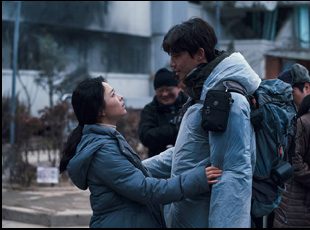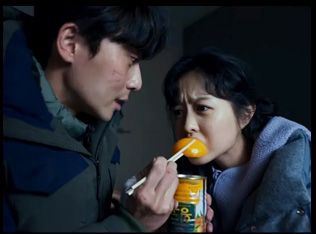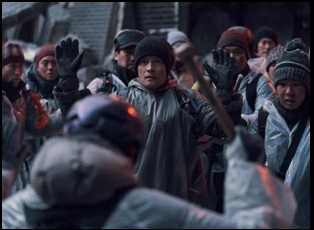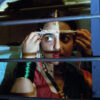One apartment building is left standing in “Concrete Utopia,” with all the others knocked over as if they were a trail of dominoes by a fickle god, an image that writer/director Um Tae Hwa simply couldn’t get out of his head after reading Kim Soong-nyung webtoon “Pleasant Outcast.” The result of a devastating earthquake in the source material, Um was inspired to envision an entirely different kind of disaster in the aftermath of the destruction of a metropolis when he grew up well aware of how fiercely competitive it was to land a place in a high-rise even in good times, with lotteries to secure a humble residence as feverish and much anticipated for some as a billion-dollar Powerball jackpot. With just the Hwang Gang Apartments remaining, the writer/director could see a conflict immediately between the haves and the have nots, as tenants at far fancier buildings would be banging down the doors for shelter at the one place left mostly untouched by catastrophe and within Hwang Gang, residents who stopped at nothing to gain entry for themselves are forced to consider the greater good.
Representing South Korea as its official entry to this year’s Oscars, “Concrete Utopia” would seem to reflect societies around the world in times of greater economic inequality than ever before and after initially seeing Min-sung (Park Seo-joon) and Myung-hwa (Park Bo-young), a young couple, reluctantly take in a mother and her young son who lost their home across the way at the glitzy Dream Palace, self-sacrifice is more difficult to come by as supplies diminish and more of a premium is placed on personal space. A leader emerges at Hwang Gang, though when few bothered to engage with their neighbors before the chaos, little is known about Yeong-tak (Lee Byung-hun) besides his heroics at extinguishing a fire in the early days after the disaster and Um finds that well before cracks made themselves evident physically, the frayed social fabric has made a crisis that much worse when no trust exists and while the residents at Hwang Gang struggle to keep their doors closed to outsiders, they find plenty they should be wary of opening inside as well.
Pitched as a black comedy at first with a bold, brassy score and lots of gallows humor as ordinary urbanites are suddenly thrust into the roles of rugged survivalists, “Concrete Utopia” starts to resonate as a more solemn consideration of what’s been lost due to the rat race mentality, particularly when the survivors of tragedy start to look no different than the rodents scurrying around the remains clinging onto whatever they can to endure. Yet Um delivers a film that’s large scale in every sense, not skimping on spectacle when depicting the force majeure nor depriving anyone of voicing their opinion in the 40-strong community meeting scenes that follow and delivering the kind of blockbuster that’s aftershocks can be felt viscerally in the moment and long after leaving the theater. On the eve of its American release after becoming a hit in its home country and its subsequent North American premiere at the Toronto Film Festival, the writer/director spoke about giving complexity to both the situation at hand and the people caught up in it, the man-made foundation for all the movie magic and how he enables his cast to stay true to their instincts.

I didn’t want to make it look like the characters in the movie are all bad or good guys, and I wanted these people to be very ordinary people when they’re in this fearful situation [and see] what kind of choices they’ll make, and with all these choices, even when you see the character making choices that you might not be able to support, I wanted you to be able to understand why they’re making those choices. I also wanted to show good characters who are motivated a little bit for their own good and even the characters who are making [bad] choices, they’re helping others. I didn’t want them to be flat, but to make them three-dimensional and more lively and realistic characters.
Were there any characters that once you cast this, the actor changed your idea of what this would be or, you know, took it in a direction you didn’t expect?
I spoke with the actors a lot and listened to their opinions. I also changed the lines a lot. The character that changed the most in this movie is Yeoung-tak. When I wrote the [script], he seemed to be hiding something from the beginning and he had a [strong] villain vibe. But as I was talking to Lee Byung-Hun after he was cast, he suggested that he wanted the character to be more clumsy and absent-minded and he was pushed under pressure to become a delegate. I agreed with that and I think that’s how the range of the transformation has increased because of [his suggestion].

I wanted to direct based on the reality of the scene. For the scene of the residents meeting, there were many people and I was wondering how I could give directions to all of them, so what ended up happening was I gave them these detailed backstories of each character — what unit they live in, the career they had before the disaster, their family members and who survived and who died — and then I told them that I would leave the acting to them. I was so happy to see the actors understand the characters so well and [inhabit them]. When I was looking at the scene, I just had to control anything that stood out too much. But other than that, these actors are just amazing. And during the scene where they try to drive Yeoung-tak away, I tried to film this as chronologically as possible and the actors had already lived as their own characters for a few months, so they had their own history and I asked them before the shoot [as their character], “What would you choose? Would you still support Yeoung-tak or would you be part of getting him out?” They answered as their character and I told them to act [in the scene accordingly]. So that’s why I think that scene has a very realistic tone. I didn’t need to give any direction.
Did thinking about the building itself actually help give shape to the story structure?
I was born and raised in an apartment, so my goal was to make this apartment as realistic as possible. From my personal experience, I used to live in an apartment with horizontal access, so we actually left the doors open and everybody pretty much lived on the same floor, and we lived like a family. We’d just go from one unit to another and visit other families. But now I think people are more isolated. You don’t really know who lives next door, and I wanted to bring that sentiment into the film and then use that as a mystery element.
It would’ve been better to shoot in a real [building], but that wasn’t possible, so we built a set that looks exactly like a real apartment building, and we matched the size and we went to the redevelopment area where there’s abandoned objects like doors, window frames, railings and wood and we were place it in the set to make it look realistic. We built [the set] up to the third floor, and above the the third floor was extended by the computer graphics and in order to make every unit look different, we put different doors and different railings.

I didn’t really have to give them a lot of detailed directions. It was pretty much described all in the script and the set was very realistic from the wind blowing to the crashed car. The actors had some kind of pre-visual image training, so they knew that what was going to be in front of them and we didn’t really have any trouble doing the computer graphics. I was really more concerned about was instead of showing the full picture of the disaster. I wanted to show a bit of it and then pan to the characters’ expression so the audience will be able to imagine what’s happening in front of these characters. Their expression is what [pulls off] the effect.
It may tell a local story, but has now played quite well around the world. What’s it been like to travel with?
When I was making this film, I wanted the Korean audience to relate to the Korean story and I made it thinking that it was a film full of Korean elements. But when I watched the film in other countries, the audience understood the story better than I thought and I saw that fundamentally, it is a story about humanity and survival, and it’s a story about human beings in general, so it’s something that people can just identify with and this is the fun aspect of cinema.
“Concrete Utopia” opens in limited release on December 8th before expanding on December 15th.




